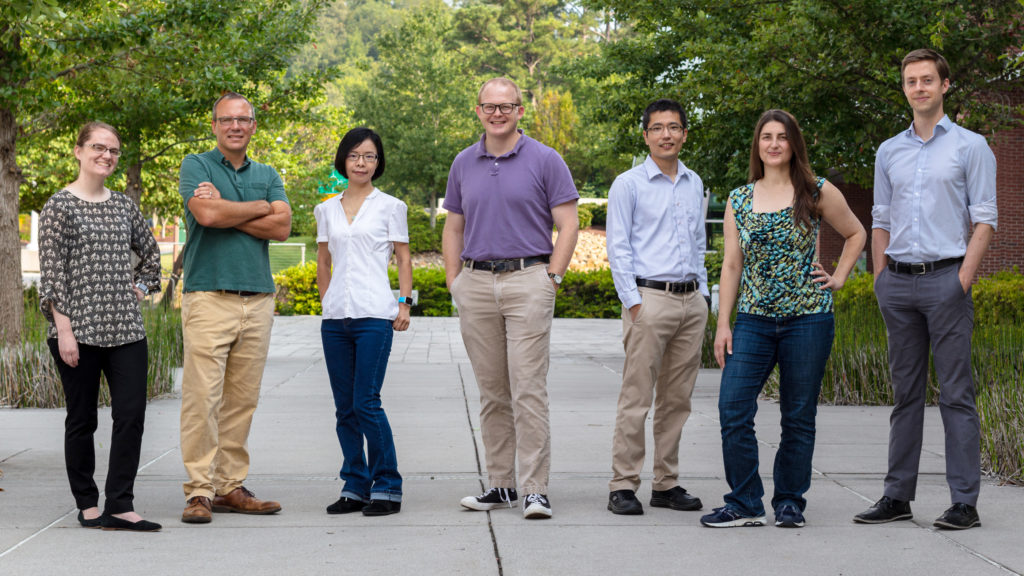By Abby Bower
Seven Oak Ridge National Laboratory researchers representing a range of scientific disciplines have received Department of Energy’s Office of Science Early Career Research Program awards.
The Early Career Research Program, now in its tenth year, supports the development of individual research programs of outstanding scientists early in their careers and stimulates research careers in the disciplines supported by the DOE Office of Science.
“Supporting our nation’s most talented and creative researchers in their early career years is crucial to building America’s scientific workforce and sustaining America’s culture of innovation,” said Secretary of Energy Rick Perry. “We congratulate these young researchers on their significant accomplishments to date and look forward to their achievements in the years ahead.”
Leah Broussard, a Wigner Fellow working in ORNL’s Physics Division, was chosen by the Office of Nuclear Physics for her proposal, “Systematics of Precision Neutron Physics Experiments.”
Broussard will devise a set of simulations, using ORNL’s high performance computers, and take measurements using tools designed to characterize the behavior of neutrons and their decay products during two high-sensitivity experiments—ORNL’s Neutron Electric Dipole Moment (nEDM) and Neutron “a” and “b” (Nab). These tools are expected to advance next-generation experiments to detect new particles and their interactions beyond the Standard Model of particle physics, help shed light on the enigma of dark matter and aid in resolving the puzzle of why there is matter but almost no antimatter in the universe.
Miaofang Chi, of ORNL’s Center for Nanophase Materials Sciences, was selected for her proposal, “Probing Anionic Electron Behavior in Electrides,” by the Office of Basic Energy Sciences.
With unusual structures featuring loosely-arranged electrons, recently discovered electride materials offer properties that could transform future nanoelectronics and energy technologies. Chi’s research will develop the first experimental technique to probe these materials and observe their responses using scanning transmission electron microscopy. Her findings could expand researchers’ ability to study electrides and further launch the development of new materials for broad energy applications.
Lucas Lindsay’s proposal, “Elucidating the Nature of Chiral and Topological Phonons in Materials for Energy Technologies,” was selected by the Office of Basic Energy Sciences. Lindsay works in ORNL’s Materials Science and Technology Division.
His project will use theoretical techniques and artificial intelligence to understand atomic vibrations called “phonons” to optimize heat flow in materials on the atomic level. Because thermal processes are critical to energy generation and use, the outcome of this work will provide fundamental insights into developing novel materials to advance energy technologies.
Joseph Lukens, of ORNL’s Computational Sciences and Engineering Division, received funding for his proposal, “Scalable Architectures for Hybrid Quantum/Classical Networking,” from the Office of Science Advanced Scientific Computing Research program.
His project seeks to overcome technical challenges of quantum communication network development by researching, designing and testing a new generation of photonic technologies that exploit the dual nature of light—particle and wave—to transmit quantum information over long distances. The goal is to develop quantum systems that leverage existing optical technologies and can coexist with classical networks in the same fiber-optic telecommunication infrastructure.
Josh Michener, of ORNL’s Biosciences Division, was selected for his proposal, “Systems Metabolic Engineering of Novosphingobium aromaticivorans for Lignin Valorization,” by the Office of Biological and Environmental Research.
This research will genetically engineer a bacterium to convert lignin—a polymer found in plants—into a value-added bioproduct. Lignin conversion would offer a source of additional revenue to improve the economics of biofuel production. Michener has developed a novel genetic method that he will employ to build a systems biology model of this bacterium and enable predictive biological engineering.
Catherine Schuman, who works in ORNL’s Computer Science and Mathematics Division, received funding for her proposal, “Learning to Learn: Designing Novel Neuromorphic Algorithms with Machine Learning,” from the Office of Science Advanced Scientific Computing Research program.
The project will use machine learning and high-performance computing to automatically create new algorithms that will enable real-time continuous learning for neuromorphic systems, which are novel, energy efficient computing systems inspired by biological neural networks. The work aims to provide a path forward for using neuromorphic computers for real-time adaptive machine learning-based analysis of scientific data.
Yangyang Wang’s proposal, “Fingerprinting Macromolecular Flow and Deformation with Neutrons,” was selected by the Office of Basic Energy Sciences. Wang works in the Center for Nanophase Materials Sciences at ORNL.
He will combine neutron-based techniques with computer simulation to characterize the way polymers behave under stress—their dynamic “fingerprint”—an important insight considering more than 300 million tons of polymers are used across critical industries each year. This approach will unlock key information about the flow and deformation behavior of polymers at a molecular level and inform the design and discovery of new materials.
National lab recipients will receive $500,000 per year to cover year-round salary plus research expenses over a planned five years. The final details for each project award are subject to final grant and contract negotiations between DOE and the awardees.
ORNL is managed by UT-Battelle for the Department of Energy’s Office of Science, the single largest supporter of basic research in the physical sciences in the United States. DOE’s Office of Science is working to address some of the most pressing challenges of our time. For more information, please visit http://science.energy.gov.
